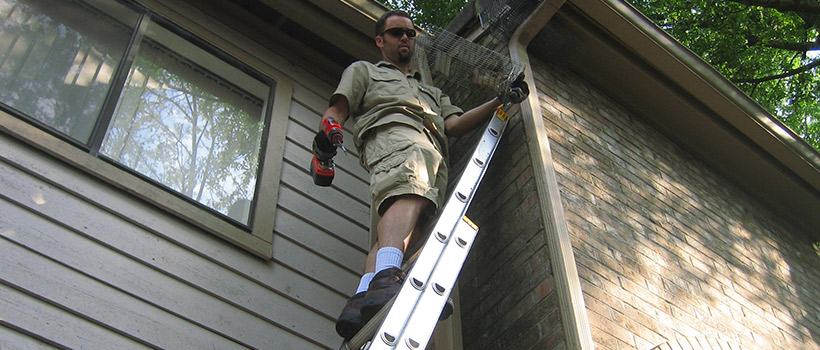If you have wild animals living inside your attic or any part of your house, you need to find out how they are getting inside. That's the most important part of the wildlife removal process. You must inspect every
square inch of your building and find the entry holes. You'll never solve a problem with rats, mice, bats, or squirrels without this step, and it's also very important in a case of raccoons or opossums inside a
house, not to mention flying squirrels, birds, snakes, and more.
If you need wildlife removal help and don't live in Florida, click here for the
National Directory of Wildlife Trappers servicing 98% of the USA population.
 How to inspect your house to find wild animal entry holes
How to inspect your house to find wild animal entry holes
Different kinds of wild life tend to seek shelter in one’s attic, porch or chimney etc. In order to check whether there are any entry holes for the wildlife one needs proper equipment along with training to see whether unwanted guest are present in the house or not.
First of all one should be well aware of the wildlife in their neighborhood in before starting the inspection so that they have a clue what all they will be looking for during the inspection. One should be familiar with the species with regard to their habitant style. Like what type of wild life would prefer floors and what kind would one find in the roof tops or vents etc. Moreover what sort of hole would they require or dig in order to make that place their habitant.
Openings: Any sort of opening is an attraction for animals. Moreover these opening also increase one’s bills as maintaining temperature becomes a problem due to them. So one should inspect the house thoroughly for holes large enough for rats to enter the premises or inhabit them. In order to start the inspection look at the house design to check for potential places for wildlife entry. The tools one require for inspection would be as follows:
- Binoculars
- Flashlight
- Camera record
Binoculars are used to look at the parts which are too high to reach for instance vents, roof tops, or chimneys especially when availability of ladder is not possible.
Flashlight can be used to see the darker regions of the house where proper light is not available for example chimneys etc.
Camera Record is required so that one would not miss a place to be sealed by the end of the day after the inspection of the entire house. Moreover, camera will help in recording places for inspection where one might have missed the place during the inspection.
When starting with the inspection one need to go step by step. The inspection should starts as appended below:
- Foundation
- Roof
- Attic
- Chimneys
Foundation
- Thorough inspection of the floor for any hole or opening. Check the sewerage pipes and other vents and there covers if any missing for openings and any residual of animals left there. Furthermore, the wire or cable connection of the house and their exit points should also be taken in consideration as they can provide wildlife an entry point.
- Check all sort of building material that is coming into the house in huge piles as they can be transporters for this wildlife into the main house. A broken brick, gaps in the tiles provide the passage of entry too.
- Furthermore holes are of different shape and sizes make sure that one is not missing the smaller one out considering that they might not be capable of providing entry leverage to wildlife.
Roof
- Use the binocular or ladder to check the loose tiles or vents. Also check for trim boards or tiles away from the walls thus providing a space for the wildlife. Even deteriorated tiles have small hole in them where wildlife can be found.
Attic
- In order to inspect the attic for droppings or signs of deteriorated material due to chewing or wildlife house material a good flash light can be very helpful for this work.
- Moreover, the inspect intersections, vents of exhausts, or cables in the roof of the attics.
- After the inspection if any spaces of holes are found don’t seal them right away make sure no wildlife has inhabitant them. Be very careful before inspecting the spaces as it would be difficult to find wildlife in narrow spaces or there might be bats which won’t be visible to the naked eye. Such animals need different kind of inspection. One should look for quarter inch pallets which can be easily crumbled and are shiny. Moreover, a bat watch can also be helpful in this regard in order to confirm their presence in the house.
Chimneys
Use a flash light to inspect the chimneys for wildlife signs specially on the smoke shelves and dampers
- Use a chimney sweeper to check it from the roof top for wildlife habitants
- Do check of the lid of animal proof cap is still intact or broken or is damage thus making it feasible for the wildlife to reside there.
Further one should also inspect the trash containers and secure them with ropes. Furthermore make it a point to put the trash out every morning and don’t leave it overnight. Bad odors also attract wildlife to the location.
Thus in order one conduct a good inspection of the house keeping the knowledge appended above could be very useful in this regard.